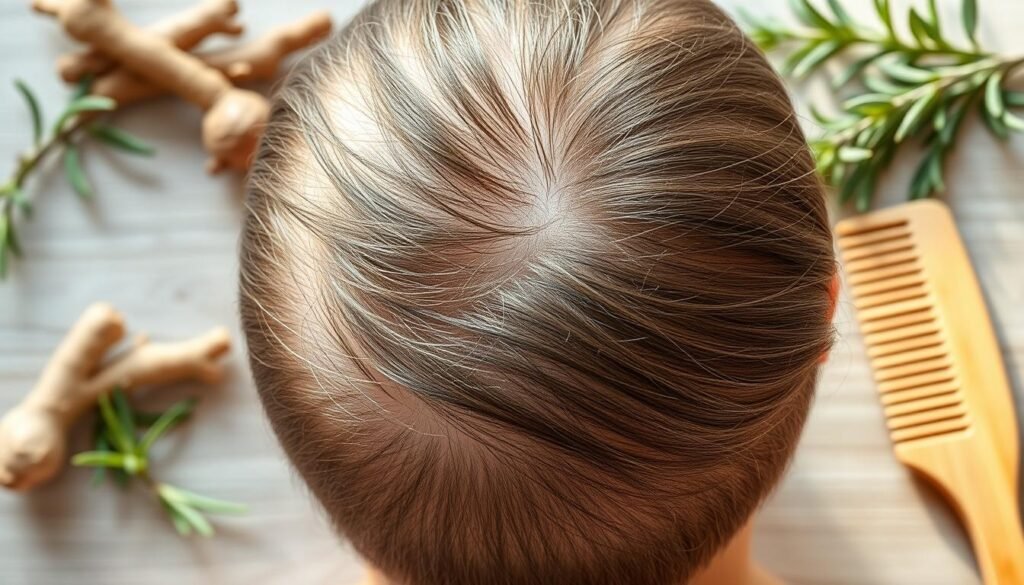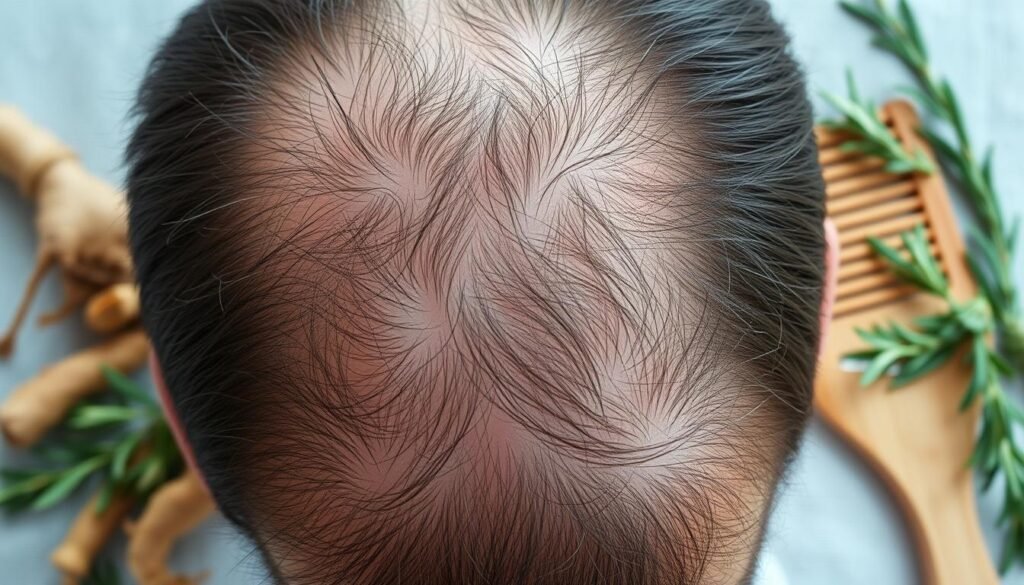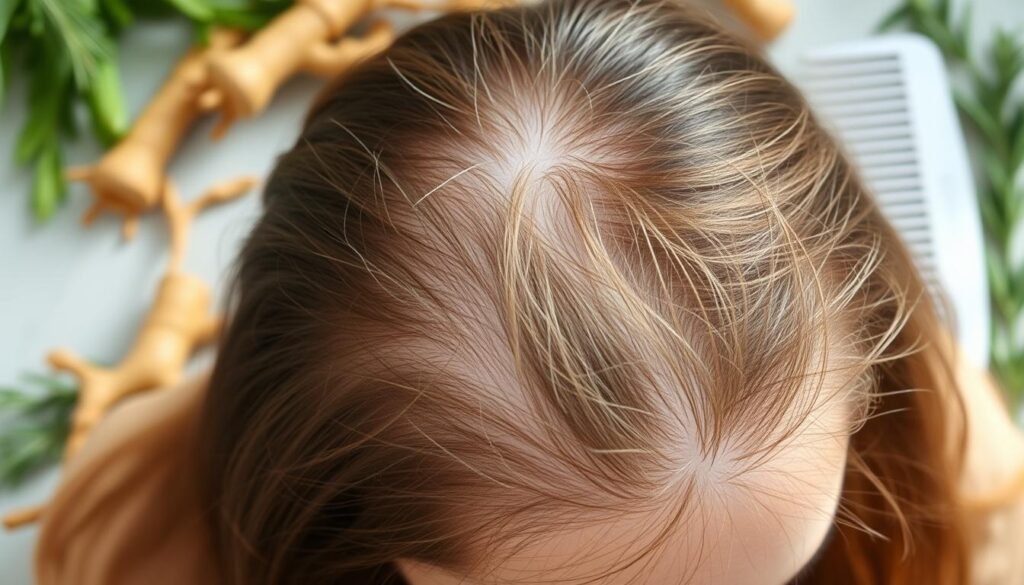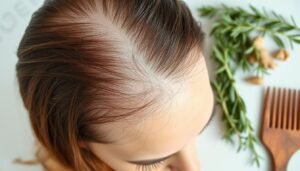Do you know 80 million Americans deal with hair loss, also known as alopecia? It’s a big issue, affecting how we look and feel about ourselves. Hair loss can come from many things, like our genes, hormones, and the environment. Knowing why we lose hair is key to finding ways to stop or treat it.
There are many ways to tackle hair loss, from stopping it from happening to making hair grow back. By looking into new research and treatments, you can start on the path to a fuller head of hair.

Key Takeaways
- Hair loss affects over 80 million Americans, with most people losing around 100 strands of hair daily.
- Understanding the causes of hair loss is crucial for prevention and treatment, including genetics, hormonal changes, and environmental factors.
- A daily protein intake of 40 to 60 grams and certain vitamins and minerals, such as vitamins A, B, C, D, E, zinc, and iron, can support hair growth.
- Low-level laser light therapy devices and minoxidil have been approved by the FDA for hair growth, offering hope for those experiencing hair loss.
- Prevention strategies, including gentle hair products, minimizing heat styling, and protecting your hair from environmental pollutants, can help maintain hair health and prevent hair loss.
- Professional treatments, such as PRP therapy or laser therapy, can be effective in promoting hair growth and preventing loss for individuals experiencing significant hair thinning.
- Regular scalp and hair health examinations can identify issues early, allowing for prompt treatment and prevention of further hair loss.
Understanding Hair Loss: What You Need to Know
Hair loss is a common problem that many people face. Up to 50% of people deal with it, especially those with androgenic alopecia. The hair growth cycle has three phases: anagen, catagen, and telogen. Knowing this cycle helps us spot excessive hair loss and signs of hair loss.
The American Academy of Dermatology says losing 50 to 100 hairs a day is normal. This is part of the hair growth cycle. But, excessive hair loss is something to worry about. Look out for receding hairlines, thinning spots, and a lot of shedding as signs of hair loss.
To understand hair loss better, know the difference between normal and excessive hair loss. While some hair loss is natural, excessive hair loss might mean there’s a problem. Spotting signs of hair loss early can help you get professional help sooner.
Common Types of Hair Loss in Men and Women
Male pattern baldness, also known as androgenic alopecia, is the most common cause of baldness. It affects over 50 million men in the United States. Hair loss starts from the temples and recedes the hairline.
Female hair loss starts with thinning hair on the crown of the scalp. Many women also see a broadening of their hair part.
Alopecia areata causes sudden hair loss, often in circular bald patches. It affects about 2% of people at some point. Other types include telogen effluvium, anagen effluvium, and cicatricial alopecia, each with unique causes.
Knowing the different types of hair loss is key for diagnosis and treatment. Recognizing signs and symptoms helps individuals seek medical help. This way, they can find the right treatment for their hair loss.
Hair loss can be due to genetics, hormonal imbalances, or medical conditions. In some cases, it’s a sign of an underlying health issue. It’s important to see a healthcare professional for evaluation and treatment. With the right approach, individuals can manage their hair loss and feel confident again.
The Science Behind Hair Loss: Causes and Triggers
Hair loss is a complex issue, and understanding its causes is crucial for effective treatment. Research shows that genetic factors play a big role, with about 80 million Americans experiencing hereditary hair loss. Hormonal influences also contribute, especially in those with polycystic ovary syndrome (PCOS) or thyroid diseases.
Certain medical conditions can lead to hair loss, like alopecia areata, an autoimmune condition. Lifestyle factors such as chronic stress, poor diet, and toxins can also cause hair loss. The American Academy of Dermatology Association says it’s normal to shed 50 to 100 hairs daily. But, losing more hair can signal a problem.
A study by the National Institutes of Health found that genetic factors account for about 80% of hair loss cases. Hormonal influences can make hair loss worse, especially in those with androgenetic alopecia. Here’s a table that summarizes common causes of hair loss:
| Cause | Description |
|---|---|
| Genetic Factors | Hereditary hair loss, accounting for 80% of cases |
| Hormonal Influences | Conditions like PCOS, thyroid diseases, and androgenetic alopecia |
| Medical Conditions | Alopecia areata, autoimmune conditions, and certain diseases |
| Lifestyle Factors | Chronic stress, poor diet, exposure to toxins, and other environmental factors |
Diagnosing Hair Loss: When to See a Professional
When dealing with diagnosing hair loss, getting professional help is key. A dermatologist or trichologist can check your scalp and hair follicles. They look for signs of hair loss.
Signs like a lot of hair shedding, thinning, or bald spots mean you should see a pro. A dermatologist might do tests like a pull test or blood tests. These help figure out why you’re losing hair and how to stop it.
Here are some important points to think about when looking for professional help for diagnosing hair loss:
- Six or more strands of hair falling out during a pull test indicates active hair loss
- Trichometric analysis using the Folliscope® magnifies images by up to 100 times, allowing detailed examination of hair follicles
- Blood tests can indicate iron deficiency, which is commonly low in menstruating women, individuals with anemia, and vegetarians or vegans
Getting professional help and a detailed hair loss diagnosis can lead to effective treatment. It’s crucial to talk to a dermatologist or trichologist. They can find the best treatment for you and help fix any hair loss problems.
| Test | Description |
|---|---|
| Pull Test | Measures the number of hairs that fall out when pulled |
| Trichometric Analysis | Examines hair follicles using a Folliscope® |
| Blood Tests | Checks for iron deficiency, thyroid diseases, and hormonal imbalances |
Essential Prevention Strategies for Healthy Hair
To prevent hair loss and keep hair healthy, you need good hair care, a balanced diet, and lifestyle changes. Eating well, with lots of vitamins and minerals, is key for hair growth. Also, getting regular trims helps avoid split ends and breakage.
Some important tips for healthy hair include using less heat styling tools, wearing loose hairstyles, and drinking plenty of water. Scalp massages boost blood flow, which is good for hair follicles and growth. Managing stress, like through meditation and yoga, is also helpful since stress can cause hair loss.
By adding these strategies to your daily life, you can encourage healthy hair growth and lower hair loss risk. Don’t forget to sleep well, as not enough sleep can make hair loss worse. With the right hair care, lifestyle changes, and diet, your hair can stay healthy and strong.
| Tips for Healthy Hair | Benefits |
|---|---|
| Reduce heat styling tool use | Prevents hair damage and breakage |
| Wear loose hairstyles | Reduces hair loss and breakage |
| Stay hydrated | Promotes healthy hair growth |
By following these tips and making a few simple lifestyle changes, you can keep your hair healthy and strong. This will also help lower the risk of hair loss. Always put your hair care first and take steps to promote healthy hair growth.
Medical Treatments and Solutions
For those dealing with hair loss, many medical options are available. These treatments can help grow hair and stop more loss. They include medicines and therapies for different hair loss types.
Common treatments include topical minoxidil, oral finasteride, and corticosteroid injections. They can work alone or together for better results. For instance, minoxidil may take 4 months to a year to show results. Finasteride starts working in about 4 months with daily use.
It’s crucial to talk to a doctor before starting any treatment. They can find the cause of hair loss and suggest the best treatment. Sometimes, a mix of medicines is needed for the best results.
Also, new hair growth solutions like low-level laser therapy (LLLT) and platelet-rich plasma (PRP) therapy are being studied. These options offer hope for those losing hair.

| Treatment | Effectiveness | Time to Results |
|---|---|---|
| Topical Minoxidil | Noticeable hair thickening | 4 months to 1 year |
| Oral Finasteride | Significant hair growth | Up to 12 months |
| Corticosteroid Injections | Hair regrowth | Varies |
Exploring these medical treatments and hair growth solutions can help find the best way to address hair loss. This way, individuals can promote healthy hair growth.
Natural Remedies and Alternative Approaches
For those dealing with hair loss, natural remedies can be a good choice. Herbal solutions like rosemary and pumpkin seed oil help promote hair growth. Essential oils, such as peppermint and coconut oil, also stimulate hair growth and improve scalp health.
Some top natural remedies for hair loss include:
- Rosemary oil, which is as effective as minoxidil for hair growth
- Pumpkin seed oil, which blocks DHT, a hormone causing male pattern baldness
- Onion juice, which boosts hair growth thanks to its sulfur content
Scalp massage can also make hair thicker by improving blood flow. It’s important to use these remedies with medical advice for the best results.
Adding natural remedies like herbal solutions and essential oils to your hair care can help. Remember, hair loss experiences vary, so what works for one might not work for another. Always talk to a healthcare professional before trying new hair loss treatments.
| Remedy | Benefits |
|---|---|
| Rosemary oil | Promotes hair growth, similar to minoxidil |
| Pumpkin seed oil | Blocks the formation of DHT, a hormone linked to male pattern baldness |
| Onion juice | Promotes hair growth due to its sulfur content |
Hair Restoration Procedures and Surgical Options
For those with significant hair loss, hair restoration is a good option. Methods like follicular unit strip surgery (FUSS) and follicular unit extraction (FUE) move healthy hair follicles to thinning spots. About 60% of new hair growth is seen 6-9 months after the transplant.
Non-surgical options are also available. These include low-level laser therapy, platelet-rich plasma (PRP) therapy, and scalp micropigmentation.
Important things to consider about hair restoration include:
- Cost: Hair transplant surgery costs between $4,000 and $15,000 on average.
- Recovery time: Most can go back to work in 2-5 days after surgery.
- Effectiveness: About 68% of surgeons say one procedure is usually enough for a successful transplant.

| Procedure | Effectiveness | Recovery Time |
|---|---|---|
| Hair Transplant | 60% new hair growth after 6-9 months | 2-5 days |
| Low-Level Laser Therapy | Improves hair density after several weeks | None |
| PRP Therapy | 50% of patients experience hair regrowth after several sessions | None |
Living with Hair Loss: Emotional Support and Coping Strategies
Living with hair loss can deeply affect your emotions. Finding the right support and strategies is key. Studies show that about 60% of men with hair loss feel less confident and more anxious. This can harm their mental health and how they interact with others.
It’s important to face the emotional side of hair loss head-on. Seeking help from loved ones, joining support groups, and taking care of yourself can help. Activities like exercise, yoga, or meditation can also help manage stress. This might even affect hair loss cycles.
Here are some effective ways to cope with hair loss:
- Seeking professional counseling or therapy to address anxiety or depression
- Using stylish accessories, such as hats, scarves, or wigs, to boost confidence
- Joining support groups to connect with others who are experiencing similar challenges
- Practicing self-care and focusing on overall well-being
By facing the emotional side of hair loss and finding the right support, you can improve your life. Research shows that men who get hair restoration can feel 70% more confident and better about themselves after treatment.
Remember, hair loss is not just physical. It also affects your emotions and mind. By tackling these issues and getting the right support, you can take charge of your hair health. This can greatly improve your overall well-being.
| Emotional Impact | Percentage of Men Affected |
|---|---|
| Compromised self-esteem | 60% |
| Increased anxiety levels | 60% |
| Depression | Not specified |
Latest Innovations in Hair Loss Treatment
The field of hair loss treatment is seeing big changes with new technologies. Millions worldwide, including over 6 million Americans, suffer from hair loss. Current treatments can be painful and have many side effects, making new, safe options crucial.
Studies are showing promise with microneedle patches. These patches use materials like hyaluronic acid to deliver drugs and fight inflammation. They’ve worked well in mice, helping hair grow back and reducing inflammation. The hair transplant market is also growing fast, expected to hit over €24 billion by 2027.
New drugs like Olumiant and Litfulo are being approved for hair loss. These drugs are more targeted and less invasive. As research keeps going, we’ll see even more new treatments for hair loss.
New technologies and treatments are very promising for hair loss sufferers. With more studies and research, we’re seeing more safe and effective options. The future of hair loss treatment looks bright, with big changes on the horizon for millions worldwide.
| Treatment | Description | Results |
|---|---|---|
| Microneedle Patch | Utilizes biocompatible materials for drug delivery and inflammation reduction | Successful in mice, allowing hair regrowth and reducing inflammation |
| Olumiant | Approved for severe alopecia areata | Shown to promote hair regrowth in some participants |
| Litfulo | Approved for adolescents with alopecia areata | Demonstrated substantial scalp hair coverage in 23% of participants |
Conclusion: Taking Control of Your Hair Health Journey
As you finish this guide, remember you have the power to change your hair health. Understanding hair loss causes and using prevention strategies can help. You can improve your hair by changing your diet, using better hair care, or getting medical help.
Your hair shows how well you’re doing overall. Taking care of it means you’re caring for yourself. Use the advice from this guide and talk to experts for a plan that fits you. With the right steps, you can get the hair you’ve always wanted.
Your hair care journey is ongoing, but you can make it better. Stay active and make smart choices for the hair you want. Start this journey with confidence, knowing you have the tools to improve your hair’s health.
FAQ
What is the hair growth cycle?
The hair growth cycle has three phases: anagen (growth), catagen (transitional), and telogen (resting). Knowing this cycle helps us understand normal versus excessive hair loss.
What are the signs of progressive hair loss?
Signs include a receding hairline, thinning scalp areas, and excessive shedding. You might find more hair in your brush, on your pillow, or in the shower.
What are the common types of hair loss in men and women?
Common types include male pattern baldness, female pattern hair loss, and alopecia. Each affects people differently.
What are the main causes of hair loss?
Hair loss can come from genetics, hormonal imbalances, medical conditions, and lifestyle choices. Knowing the cause is key to treating it.
When should I see a professional for hair loss?
See a dermatologist or trichologist for significant, persistent, or progressive hair loss. They can diagnose and treat effectively.
What are some preventive measures for maintaining healthy hair?
Eat a balanced diet, use gentle hair care, and manage stress. Avoid smoking to keep your hair healthy.
What medical treatments are available for hair loss?
Treatments include medications, therapies, and surgeries like hair transplants. A healthcare professional can help choose the best option.
Are there any natural remedies for hair loss?
Natural remedies include herbal supplements, essential oils, and scalp care. Always get professional advice for the best results.
What are the different hair restoration procedures available?
Procedures include surgical options like strip harvesting and follicular unit extraction, and non-surgical treatments like low-level laser therapy. Knowing the pros and cons is important.
How can I cope with the emotional impact of hair loss?
Seek support, practice self-care, and focus on well-being. Addressing emotional challenges is key to improving your quality of life.
What are the latest innovations in hair loss treatment?
New treatments include stem cell therapy, gene therapy, and ongoing studies. These advancements promise more effective solutions in the future.
Source Links
- https://health.clevelandclinic.org/how-to-stop-hair-loss
- https://muskclinic.com/hair-loss-prevention-secrets/
- https://www.piedmont.org/living-real-change/what-you-can—and-cant—do-to-stop-hair-loss
- https://www.healthline.com/health/hair-loss
- https://www.samitivejhospitals.com/article/detail/hair-loss
- https://nyulangone.org/conditions/hair-loss/types
- https://www.mayoclinic.org/diseases-conditions/hair-loss/symptoms-causes/syc-20372926
- https://www.medicalnewstoday.com/articles/hair-loss-the-latest-science-on-causes-treatment-and-prevention
- https://pmc.ncbi.nlm.nih.gov/articles/PMC9710406/
- https://www.aad.org/public/diseases/hair-loss/causes/18-causes
- https://nyulangone.org/conditions/hair-loss/diagnosis
- https://www.aad.org/public/diseases/hair-loss/treatment/diagnosis-treat
- https://www.mayoclinic.org/diseases-conditions/hair-loss/diagnosis-treatment/drc-20372932
- https://azcdps.com/blog/10-effective-ways-to-prevent-hair-loss-tips-for-healthy-and-strong-hair/
- https://precisionmedicalhair.com/lifestyle-factors-and-hair-health-tips-to-prevent-hair-loss/
- https://aihcp.net/2024/09/06/stress-and-hair-loss-tips-for-prevention-and-management/
- https://nyulangone.org/conditions/hair-loss/treatments/medication-for-hair-loss
- https://www.aafp.org/pubs/afp/issues/2017/0915/p371.html
- https://www.harleystreethairtransplant.co.uk/8-natural-remedies-for-hair-loss/
- https://abcnews.go.com/GMA/Wellness/6-natural-remedies-hair-loss/story?id=104253823
- https://my.clevelandclinic.org/health/treatments/8307-hair-loss-treatments
- https://www.hopkinsmedicine.org/health/wellness-and-prevention/hair-replacement-surgery
- https://www.webmd.com/skin-problems-and-treatments/hair-loss/hair-transplants
- https://health.mountsinai.org/blog/living-with-alopecia-areata-five-coping-strategies-to-help-with-the-emotional-toll/
- https://pmc.ncbi.nlm.nih.gov/articles/PMC8719979/
- https://nashvillehairdoctor.com/hair-loss/mental-impact-of-hair-loss/
- https://news.mit.edu/2024/new-treatment-could-reverse-hair-loss-caused-autoimmune-skin-disease-0509
Click here to learn more about this topic in a related article.






Can you be more specific about the content of your article? After reading it, I still have some doubts. Hope you can help me.